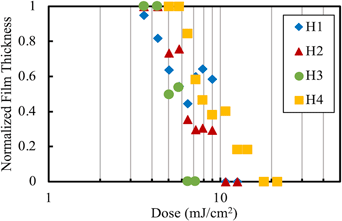Published online by Cambridge University Press: 10 September 2020

Poly(phthalaldehyde) (pPHA) and copolymers with aliphatic aldehydes were investigated as dry-develop, positive-tone photoresist. Exposure of the films loaded with a photoacid generator to 248 nm radiation creates an acid that depolymerizes the polymer into volatile monomers, allowing the development of features by vaporization rather than solution-based processes. By controlling the acid content, the vaporization rate of the reaction products, and the degree of liquid formation of the decomposed polymer, control of spatial resolution and the quality of polyaldehyde dry-develop photoresist was achieved. Heat, vacuum, and forced convection were evaluated as development techniques in determining the resist sensitivity, contrast, and resolution. Forced convection of heated nitrogen was the most controllable development method for pPHA films. Five-micron lines and spaces were printed. Poly(aldehyde) copolymer resins had slightly lower spatial resolution but were able to be developed faster due to higher vapor pressure of the depolymerized monomers. Cold photo-exposures and development were used to prevent detrimental liquid formation of the decomposed copolymers. In addition to exploring new dry-development methods that have not been tested before, these findings offer insights into designing better material systems and optimizing processes for dry-develop photoresists.